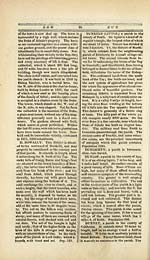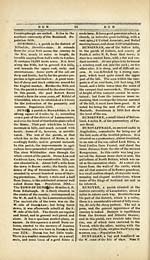Gazetteer of Scotland
(93) Page 91
Download files
Complete book:
Individual page:
Thumbnail gallery: Grid view | List view

DUN 91
soil is in general flight, with little clay or
deep loam, and by far the greater part is
uncultivated, and incapable of cultivation.
—The coast is in general bold and rocky,
but from Dunnet-head it is flat, and af-
fords safe anchorage to vessels in several
bays and harbours. Population 1398.
DUNNET-HEAD is an extensive pro-
montory, running into the Pentland Frith,
on the western border of the parish of Dun-
net. It consists cf several hills interspers-
ed with vallies. Through its whole extent
Dunnet-head presents a front of broken
rocks to the sea, the height of which varies
from 100 to 400 feet. It is joined to the
land by a narrow neck or isthmus, about a
mile and a half broad.
DUNNICHEN, aparishinthe county of
Angus, extending in length 4 miles, and
2 to 3 in breadth. It is mostly arable,
though the surface is hilly. The soil is to-
lerably fertile, and it is watered by 2 small
brooks, which rise from a neighbouring
moss. There are several extensive marl pits.
Mr Dempster, the chief proprietor, has late-
ly feued part of his ground for a village cal-
led Letham, where there is a stamp-office,
and a weekly market for the sale of yarn
and brown linens. About a mile from the
village is DUnnichen-house, the residence
of that gentleman. There is plenty of ex-
cellent freestone. Population 1233.
DUNNING, a parish in the county of
Perth, situated at the northern extremity
of the Ochil hills, where they terminate in
Strathearne. The high and moorland
parts, which aire elevated 1000 feet a- j
bove the level of the sea, are laid out for
sheep pasture- The declivities are in some
places gentle, and admit of the plough;
but the produce is scanty. In the lower parts
the soil is arable, and partakes of the na-
ture of carse land. Mr Graham of Orchil
lately fued out the village of New Pitcairn
or Dragon's Den. Duncruib, the residence
of Lord Rollo, holds a distingcished place in
the parish. The house of Keltie, is an an-
cient edifice. Population 1 723.— The VIL-
LA.GE OF DUNNING, lies 9 miles W. S.
W. from Perth. It is well situated on the
banks of Dunning-water, and contains a
number of modern built houses, which
have a good appearance. There was for-
merly a printfield here, and a goad deal of
weaving is still carried on. This village
was burnt down by the Earl of Man's army
in 1715, in their retreat from Sheriff-muir
to Perth.
DUNNQTTAR, a parishin the county 6f
Kincardine, of a triangular figure, extend-
ing about 4 miles each side. It is situated
on the coast, at the beginning of the great
how or hallow of the Mearns. The sur-
face is uneven, with frequent risings. To-
wards the coast the soil is a kind of clay
loam ; but as it recedes, it degenerates in-
to a wet gravelly moor. The sea coast is
very bold. There are many deep caves in
the rocks, which are much frequented by
gulls and other sea fowls. At the N. E. cor-
ner, where the small rivulet Carron runs
into the sea, is situated the town of Stone-
haven, having a fine natural harbour. The
turnpifc.; road from Montrose to Aberdeen
passes through the town of Stonehaven,
and another road runs directly from that
town to Perth, through the valley of
Strathmore. Thecastle of Dunnottar.now
in ruins, is situated on a perpendicular
rock, 150 feet above the level of the sea,
on a plain about 3 acres in extent, and
almost separated from the land by a
deep chasm. It forms one of the most ma-
jestic ruins in Scotland, and before the in-
vention of the artillery, must have been im-
pregnable. It was often used as a state
prison, and several of the non-conforming
Presbyterian clergy were confined in it. It
was built during the contest between Bruce
and Baliol; and so great was its reputation
for strength, that in 1651 it was used for
the deposit of the regalia of Scotland, td
preserve them from the English army. Po-
pulation 1S86.
DUN-O-DEER, a hill in Aberdeenshire-,
upon which are the ruins of a vitrified fort
or castle.
DUNOON, a parish in Argyleshire, situ-
ated in the district of Cowal, on the W.
Side of the Frith of Clyde. It extends a-
bout 24 miles hi length, and on an average
2 in breadth. The general appearance
of the country is flat and agreeable, bavin*
n few eminences covered with natural wood
in the back parts of the parish. Formerly
the village of Dunoon was very considera-
ble, and- a place of resort on account of
a ferry, which was the principal inlet to the
district ; but a new road being opened by
Loch Lomond, around the head of Loch
Long, has contributed to its decay. The
castle of Dunoon, in the neighbourhood of
the village, was once a royal residence, of
which the family of Airgyle were hereditary
constables. Population 2130.
DUNREGGAN, a village in the county
of Dumfries, 1G miles and a half N. W.
from Dumfries.
DUNROSSNESS, a parish in Shetland,
to which the parishes of Sandwick *n&
soil is in general flight, with little clay or
deep loam, and by far the greater part is
uncultivated, and incapable of cultivation.
—The coast is in general bold and rocky,
but from Dunnet-head it is flat, and af-
fords safe anchorage to vessels in several
bays and harbours. Population 1398.
DUNNET-HEAD is an extensive pro-
montory, running into the Pentland Frith,
on the western border of the parish of Dun-
net. It consists cf several hills interspers-
ed with vallies. Through its whole extent
Dunnet-head presents a front of broken
rocks to the sea, the height of which varies
from 100 to 400 feet. It is joined to the
land by a narrow neck or isthmus, about a
mile and a half broad.
DUNNICHEN, aparishinthe county of
Angus, extending in length 4 miles, and
2 to 3 in breadth. It is mostly arable,
though the surface is hilly. The soil is to-
lerably fertile, and it is watered by 2 small
brooks, which rise from a neighbouring
moss. There are several extensive marl pits.
Mr Dempster, the chief proprietor, has late-
ly feued part of his ground for a village cal-
led Letham, where there is a stamp-office,
and a weekly market for the sale of yarn
and brown linens. About a mile from the
village is DUnnichen-house, the residence
of that gentleman. There is plenty of ex-
cellent freestone. Population 1233.
DUNNING, a parish in the county of
Perth, situated at the northern extremity
of the Ochil hills, where they terminate in
Strathearne. The high and moorland
parts, which aire elevated 1000 feet a- j
bove the level of the sea, are laid out for
sheep pasture- The declivities are in some
places gentle, and admit of the plough;
but the produce is scanty. In the lower parts
the soil is arable, and partakes of the na-
ture of carse land. Mr Graham of Orchil
lately fued out the village of New Pitcairn
or Dragon's Den. Duncruib, the residence
of Lord Rollo, holds a distingcished place in
the parish. The house of Keltie, is an an-
cient edifice. Population 1 723.— The VIL-
LA.GE OF DUNNING, lies 9 miles W. S.
W. from Perth. It is well situated on the
banks of Dunning-water, and contains a
number of modern built houses, which
have a good appearance. There was for-
merly a printfield here, and a goad deal of
weaving is still carried on. This village
was burnt down by the Earl of Man's army
in 1715, in their retreat from Sheriff-muir
to Perth.
DUNNQTTAR, a parishin the county 6f
Kincardine, of a triangular figure, extend-
ing about 4 miles each side. It is situated
on the coast, at the beginning of the great
how or hallow of the Mearns. The sur-
face is uneven, with frequent risings. To-
wards the coast the soil is a kind of clay
loam ; but as it recedes, it degenerates in-
to a wet gravelly moor. The sea coast is
very bold. There are many deep caves in
the rocks, which are much frequented by
gulls and other sea fowls. At the N. E. cor-
ner, where the small rivulet Carron runs
into the sea, is situated the town of Stone-
haven, having a fine natural harbour. The
turnpifc.; road from Montrose to Aberdeen
passes through the town of Stonehaven,
and another road runs directly from that
town to Perth, through the valley of
Strathmore. Thecastle of Dunnottar.now
in ruins, is situated on a perpendicular
rock, 150 feet above the level of the sea,
on a plain about 3 acres in extent, and
almost separated from the land by a
deep chasm. It forms one of the most ma-
jestic ruins in Scotland, and before the in-
vention of the artillery, must have been im-
pregnable. It was often used as a state
prison, and several of the non-conforming
Presbyterian clergy were confined in it. It
was built during the contest between Bruce
and Baliol; and so great was its reputation
for strength, that in 1651 it was used for
the deposit of the regalia of Scotland, td
preserve them from the English army. Po-
pulation 1S86.
DUN-O-DEER, a hill in Aberdeenshire-,
upon which are the ruins of a vitrified fort
or castle.
DUNOON, a parish in Argyleshire, situ-
ated in the district of Cowal, on the W.
Side of the Frith of Clyde. It extends a-
bout 24 miles hi length, and on an average
2 in breadth. The general appearance
of the country is flat and agreeable, bavin*
n few eminences covered with natural wood
in the back parts of the parish. Formerly
the village of Dunoon was very considera-
ble, and- a place of resort on account of
a ferry, which was the principal inlet to the
district ; but a new road being opened by
Loch Lomond, around the head of Loch
Long, has contributed to its decay. The
castle of Dunoon, in the neighbourhood of
the village, was once a royal residence, of
which the family of Airgyle were hereditary
constables. Population 2130.
DUNREGGAN, a village in the county
of Dumfries, 1G miles and a half N. W.
from Dumfries.
DUNROSSNESS, a parish in Shetland,
to which the parishes of Sandwick *n&
Set display mode to: Large image | Transcription
Images and transcriptions on this page, including medium image downloads, may be used under the Creative Commons Attribution 4.0 International Licence unless otherwise stated. ![]()
| Gazetteers of Scotland, 1803-1901 > Gazetteer of Scotland > (93) Page 91 |
|---|
| Permanent URL | https://digital.nls.uk/97422810 |
|---|

